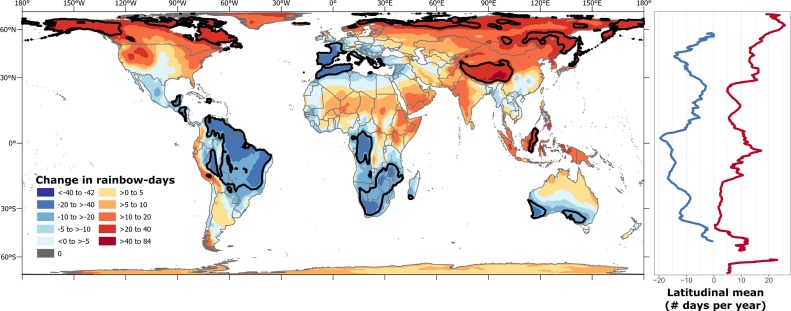What happens to rainbows as the planet’s climate changes?
 2 November 2022
2 November 2022
Climate change and its evolving impacts are touching all aspects of what it means to be human, but now there’s a new question about life on a changing planet: What happens to the rainbows?
The ability to see a rainbow depends on changing precipitation rates, cloud cover, and other conditions—the sun angle and time of day, the elevation of the land—that make them possible. While they’re not critical to sustaining life on earth, rainbows are important enough to human experience that researchers identify their value in terms of cultural ecosystem services.
“Rainbows have been part of the lived human experience throughout history and around the world and can also be found in arts, literature, music, films, folklore, religion, and mythology,” says a team of scientists that set out to understand what happens to the phenomenon of rainbows as the climate changes. Their peer-reviewed work was published in the journal Global Environmental Change.
The United States researchers, led by the University of Hawaii, say it’s the first time the question’s ever been studied. They looked at more than 7,000 verified images of atmospheric rainbows taken between February 2004 and December 2013. The photographs in the study came from every corner of the globe except for Antarctica.
They then calculated the current likelihood of a rainbow appearance in locations across the planet, measuring it against the anticipated changes in rainfall, cloud cover and other factors in order to project future rainbow rates.
For example, snow doesn’t lead to rainbows because it’s not liquid. But some places in a warming world might see snow fall as rain more often, leading to more frequent sightings of rainbows. In parts of the tropics where rainbows are common and rain is plentiful, more dry days might decrease the number of rainbows.
The measurements based in 2000, at the turn of the century, put the fewest number of rainbows in Antarctica and Greenland, and in the arid regions of northwest China, the Arabian Peninsula, and the Sahara Desert. Rainbows were most often seen in Kenya, Madagascar, Liberia, and other parts of coastal Africa, as well as in comparable climates of Central and South America. Islands like Hawaii have quite a few rainbows, too.
Depending on which climate scenario is used, and by accounting for future population shifts, the researchers determined that for many people, the chances of seeing a rainbow will go up by 2100. Still, between a quarter and a third of all global land areas may see decreases in how often one might spot a rainbow.
“Under the highest emission future (SSP5 8.5), hotspots of decline include the Mediterranean, much of Brazil and northeast South America, southern Australia, and parts of Central and Southern Africa,” the authors note.
In some cases, that may have economic impacts on tourism in places where rainbow-viewing is common, but in general the researchers say their work highlights aspects of climate change that, like natural sound, affect human well-being but are often overlooked.
“Our results underscore the fact that climate change will alter not just tangible earth system dynamics with clear socio-economic implications, but also parts of the earth system that we cannot touch, and that may affect us in more subtle ways,” they conclude.

The post What happens to rainbows as the planet’s climate changes? appeared first on Sustainability Times.
